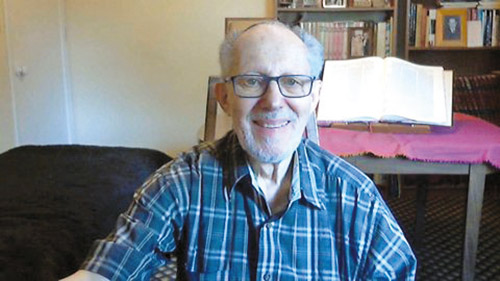

אֵלּוּ דְבָרִים שֶׁאֵין לָהֶם שִׁעוּר. הַפֵּאָה, וְהַבִּכּוּרִים, וְהָרֵאָיוֹן, וּגְמִילוּת חֲסָדִים, וְתַלְמוּד תּוֹרָה…
These are the things that have no definite quantity: The corners; first-fruits; the offerings brought on appearing at the Temple; the performance of righteous deeds; and the study of the Torah. Mishnah Peah 1:1.
It does not take a great deal of research to find a Gemara or Daf Yomi shiur in Bergen County in the early morning hours or the evening, no matter how late. But hidden in Teaneck is a jewel, unique in composition, level of learning and general ambience. In 2008, Rabbi Menahem Meier, founding principal of Yeshivat Frisch, now in Paramus, New Jersey, was approaching his retirement from the field of education. Tzipora Meier, Rabbi Meier’s wife, thought of the idea of gathering a group of retired folks in the mornings, women and men, to study works of Torah. Rabbi Meier approached Rabbi Shalom Baum, rav of Congregation Keter Torah, and broached the idea; Rabbi Baum accepted it and so “Torah in the AM” was born, a program of Congregation Keter Torah.
Participants meet from 9 a.m. to 10:45 Tuesdays and Thursdays. Starting with about five-six members, it has grown to 16 women and men, almost half women. Currently, the first 45 minutes are devoted to Tanach, and the second hour is a Gemara shiur.
If you were to accidentally “Zoom in” to “Torah in the AM” at 9:15 a.m., you would likely hear a thoroughly researched explication in chabura (learning group) volunteer leader Stanley Shapiro’s voice, a discussion of levels of meaning in Iyov, Shir HaShirim or the book of Tanach under analysis. Stanley’s close reading and attention to the detail of the p’shat (plain meaning of text) often lead to differences in the group about what a text seeks to convey. And so, you might catch a chabura member offering a heartfelt modern-day application of Tanach, brimming with life experience, and another disagreeing vehemently. I asked Stanley what motivates him to continue his generous devotion of time to the chabura; he explained: “Digging deeply is a rich challenge for me… I like the idea of group learning and [discovering] different perspectives.”
If you Zoomed-in a short half hour later, you would meet another group, some participants overlapping, taught by Rabbi Menahem Meier. R. Meier chooses the sugyot (sections) studied, and carefully sets out concepts discussed in a sugya, the Tannaim and Amoraim who will play a role in the discussion, and of course the challenges and the issues resolved. He points out the structure of the sugya and even supplies illustrations. Participants ask questions and frequently get into enthusiastic discussions of points in a sugya. Following each sugya, Rabbi Meier curates a selection of decisions by the Rambam, Shulchan Aruch, Mishnah Berurah and others that reflect the halachah surrounding the sugya.
The group has been learning together for about 13 years. What is truly extraordinary is that shiur members are of totally different backgrounds in Gemara. Some have learned Gemara since fourth or fifth grade and continued for more than 50 years, and others—like me—are relative newcomers to the deliberations of the Tannaim, Amoraim and Tosfos, with a year of Gemara under their belts, or less. And yet, when I spoke with members of the shiur individually, they each mentioned the degree to which everyone is engaged. One participant noted, “People like to contribute, to interact with Rabbi Meier.”
I asked Rabbi Meier how he was able to engage each of the students with their different backgrounds and maintain the group’s pitch of enthusiasm. He pointed me to what he had learned from Rav Joseph B. Soloveitchik’s teaching methods. “Rav Soloveitchik had great skills in teaching … he was a master pedagogue,” Rabbi Meier noted. “The key is to pose questions so that people can wrap their minds around the central idea … to frame the questions so that people can formulate their own ideas.”
“Torah in the AM” is not just a learning experience. Almost every member said that they were initially motivated to attend because they were seeking to learn Torah. Now that they finally had the time and the head-space, they decided to act on a long-time desire to learn Torah. But shiur members also emphasized the warm, welcoming spirit of the group, the willingness of the more learned individuals to help the beginners, the sense of a shared goal of forming a pleasant environment, and felt that Torah in the AM is “a comfortable group of people to learn with… a nice group of people to learn with.”
In short, there are many levels of learning going on simultaneously throughout the morning, and as one participant observed, different folks contribute different resources as they wish. The material offered by Stanley Shapiro and Rabbi Menahem Meier is high-level; what the members get out of the shiurim depends on what the members want to get out of them.
Thirteen years ago, “Torah in the AM” created a space for discussion of Torah. Anyone who is seeking to learn and talk Torah unlimited, without a “שִׁעוּר (shiur),” and in a warm, welcoming environment, is invited to join the discussion.
For detailed information about Zoom participation, please call the office at Keter Torah and ask about
“Torah in the AM.”
By Peshie Paretzky Mandelbaum, Ph.D.










